Results 51 to 60 of 170
-
10-12-2018, 03:09 AM #51

The folks at the Cutler's Company have always been very helpful where it was possible. Their contact page is here.
You should definitely hone and use it. It's an extraordinary feeling shaving with such an old razor!
And sorry to have been so brief earlier, I was in the middle of things and pretty clearly wasn't able to be clear enough about the marks.
Yes, the books of marks that the Cutlers Company keeps are the definitive source on Sheffield marks. However, I have not seen the dart & pipe mark as it was recorded in their books. The only sources I've seen on it are the marks as recorded in Sketchley's directory (as seen on Fikira's excellent page), and the marks on razors.
Of the three or four 18th century marks I've gone to the Cutler's Company to get help with, none remained with a single family.
Experience has shown me that the marks as recorded in the directories are often wrong in small and large ways. Mirroring of that sort is common. That is, the mark they've recorded in the directory has reversals or even missing characters from the mark as it was recorded in the mark books and on goods. However, the directories are as good as we get for knowing who was actually working. The apprentice registries are not a good indicator. A cutler who completed their apprenticeship had no guarantee of selling their own goods -- that depended entirely on having the money to set up shop somewhere, and in the late 18th century, more often than not that meant renting space in one of the many larger wheels or having the resources to build your own workshop, which is not very likely for most. Most of those who completed their apprenticeships went on to work for another cutler.
Another note on families and the apprentice registries -- Leader's gigantic second volume of the Company's history, the one with the apprentice registries, is a pain in the butt to actually make use of, partly because Sheffield family names made matters difficult even with access to primary sources. Your note of William Bradshaw and three dates of freedom, for example, is probably referencing three different William Bradshaws. Possibly all directly related, but maddeningly, not necessarily. There were three different men named Sleigh Rowland all working in Sheffield at the same time. Two of them were in the same branch of the trades. They were, at best, second cousins.
It would be very, very odd for a general cutler to be freed three separate times over the course of 25 years.
The Bradshaw entry in the apprentice registry is an especially bad mire because of how expansive the family name was. While they were all likely distantly related, without talking to descendants, I would not assume they all thought of each other as relatives.
I can't turn up anything in the way of plausible birth or death records for a William Bradshaw to be apprenticed to John Hoole in 1730 (he would've been between 7-12 when apprenticed and his apprenticeship would have been for 7 years).
However, I did turn up a baptism of a William Bradshaw, son of William Bradshaw (cutler) in 1734. That timing works out very well to suggest (1) William Bradshaw, freed in 1730 to father William Bradshaw, freed in 1752. The 1755 freedom was probably a cousin... But finding records for folks in the early parts of the 18th century in Sheffield is a challenge. Some were lost in WWII, some were just not recorded. Some were recorded and lost in other ways. Some were recorded and haven't been digitized. The best way of finding people is headstones, but even there you run into numerous entire churchyards which are gone as well as the headstones, and even when present, many 18th century and even early 19th century headstones in Sheffield are actively difficult to decipher from the centuries of weather.
Helpfully, John Hoole is a little more traceable!

And this is almost certainly his death, despite the different spelling.
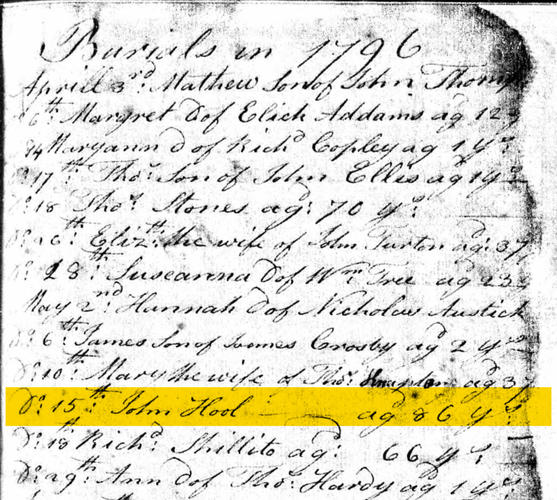 -Zak Jarvis. Writer. Artist. Bon vivant.
-Zak Jarvis. Writer. Artist. Bon vivant.
-
The Following 4 Users Say Thank You to Voidmonster For This Useful Post:
782sirbrian (10-12-2018), Geezer (10-12-2018), MikeT (10-13-2018), ScienceGuy (10-12-2018)
-
10-12-2018, 12:30 PM #52Junior Member

- Join Date
- Oct 2018
- Posts
- 19
Thanked: 25
Awesome info - thank you!
I'll definitely reach out to the Cutlers Co. directly. It's more a matter of curiosity than anything else.
To explain the research that I've done on the mark a bit more clearly:
The Bradshaw family (as you noted) was rather large and spread out. And the records that the Cutlers Company have are a pain to wade through as they are organized by last name and then by first name...which makes for a fair bit of confusion when dealing with a large family with multiple instances of the same first name.
I started with the William Bradshaw who was granted his Freedom in 1698. We know from the Cutlers Company records that he was granted the pipe and dart mark at that time (a mark was applied for when gaining Freedom, so that the individual could start on their own). Who he apprenticed to is important mainly for the location (Crookeside area) as this is the main way to trace the particular branch of the Bradshaw family that we're after.
Starting with William Bradshaw, you have multiple offspring (including William the younger)...but we're not really concerned with all of them, only the ones that were apprenticed father-to-son in the Crookeside area. There's a full line of these Bradshaws. William the younger apprenticed to John Hoole -- that puts him outside of the direct family line. Christopher and Matthew were both apprenticed to their father (William the elder) in Crookesmoor (more specific location within Crookeside area). They gained their Freedom in 1732 and 1737, respectively. You then have Joseph Bradshaw apprenticed to his father, Christopher, and gaining his Freedom in 1762. If we assume he was the minimum age to be granted Freedom (21), that would have him born in 1741, nine years after Christopher was granted his Freedom, placing Christopher at approximately 30 years of age when he fathered Joseph.
It was this direct line of father-son apprenticeships within the Crookeside area (or, more specifically, on Crookesmoor) that I was using. In particular for father-son apprenticeships, it was common for the father's mark to be passed onto the son -- the Cutlers Company allowed this without the rigamarole of applications normally necessary for a mark.
-
The Following User Says Thank You to srsimon For This Useful Post:
Voidmonster (10-12-2018)
-
10-12-2018, 01:07 PM #53

Djeez! I need a week to read this alone!
Amazing you guys! Putting a smile on my face!
Excuse me if I write something useless because I haven't read everything yet but I would also place this beautiful razor around 1760-1770
I'm hoping that Joan can the original entree of this mark, that would be truly helpfull
I also know some pipe marks are reversed ( article tobacco pipe/ Birks) but I need more time to focus around this
Thanks!
-
10-12-2018, 01:16 PM #54

I'm with Zak (Voidmonster) on this one regarding the physical state of the razor. I'm VERY interested to see what it looks like when you get it. The scales are certainly in tip-top shape so this one was well cared for. But I ultimately decided not to bid to the max at the last minute because it looks to me like this has an extreme amount of hone wear (I would wager up to 1/4"). I attach a picture with the brightness/contrast adjusted to point out the wear lines that are shiny steel right in the places that would be expected. Also Zak is right - on all of these razors the original set edge sits either at the level of the tang or very slightly below it. See the bottom attached images for two examples of this on some of the closest to NOS razors from the period I have obtained. I believe these are corroborated as having original grinds because the blade face shows the exact type of grind lines as seen on other parts of the razor (you can see them on the closeup of the tang of yours - they are a series of faint but regularly-spaced lines). Most original razors of the period I have show these lines (and another tell is that the top of the tang has the same lines but often in a diagonal grind). As a final point it looks like the wear on yours follows the trace of the dip, but in the more intact examples this is presented as a straight line across the top. I don't want all this to sound negative though - I am really excited to see this once you get it in and cleaned up.
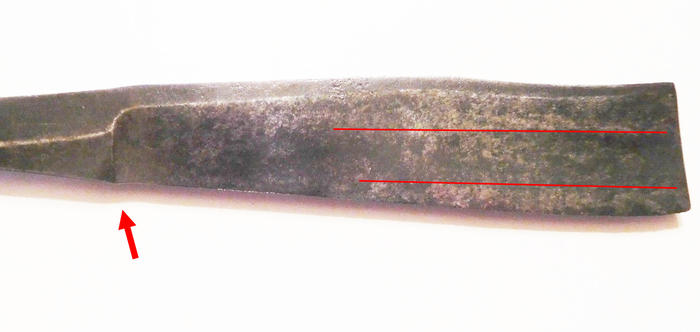
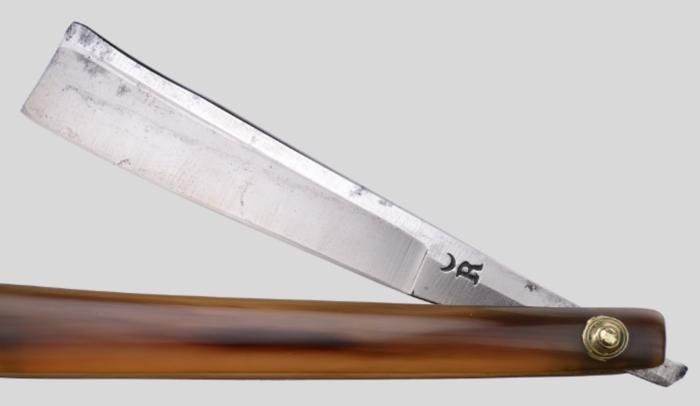
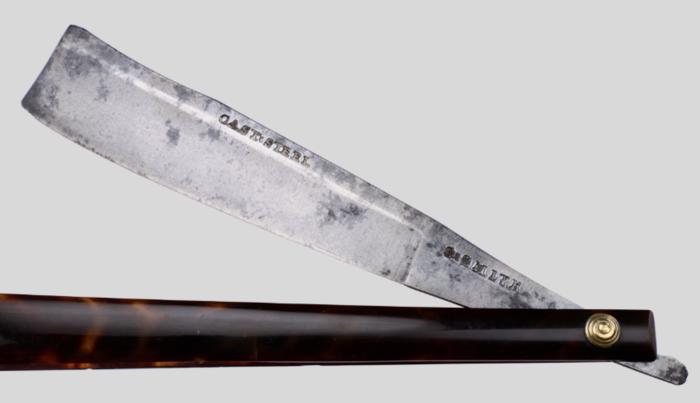
The type of scratch patterns in question:
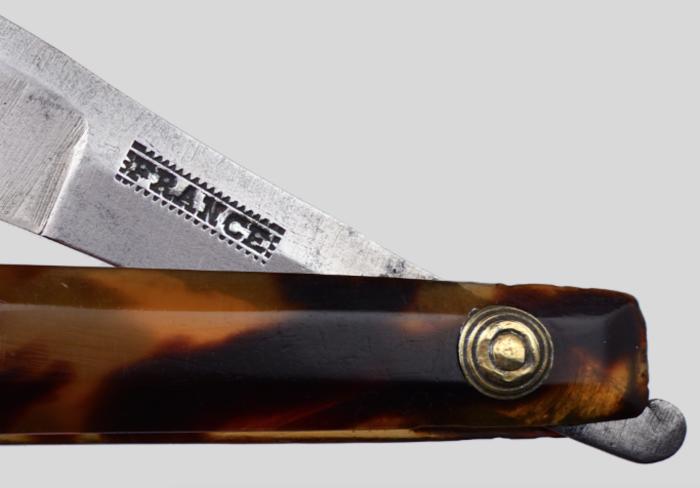
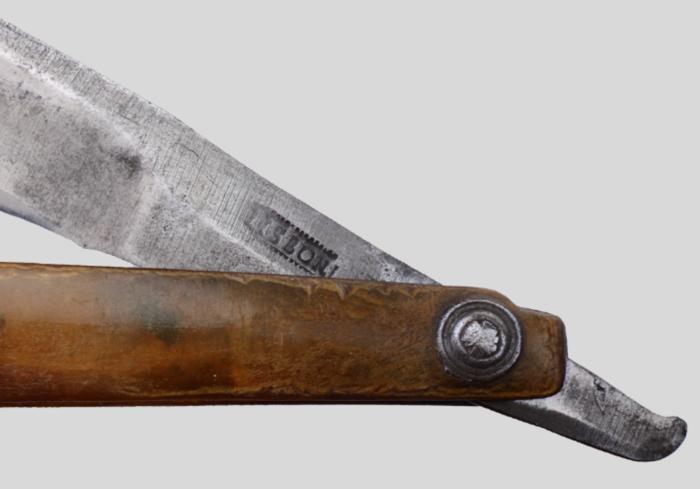
Diagonal scratch pattern of same spacing, top of tang:

-
The Following 2 Users Say Thank You to ScienceGuy For This Useful Post:
MikeT (10-13-2018), Voidmonster (10-13-2018)
-
10-12-2018, 01:23 PM #55

Also absolutely +1 for contacting Joan at the Cutlers Company. I visited her the last time I was in the UK and they were INCREDIBLY helpful and hospitable, even offering a private tour of the Hall and pulling out the Book of Marks to show me. Reading some of Leaders, talking to others here, and talking to her, I'm still not sure I fully understand the exact processes of how marks were or were not passed / inherited / nullified and re-used.
-
10-12-2018, 01:27 PM #56Junior Member

- Join Date
- Oct 2018
- Posts
- 19
Thanked: 25
Waiting on shipping notification...should have the razor next week and we'll see how it looks in person (and cleaned up). Not going to be buffing it (it earned that patina), but will clean and hone, which should give a better indication of where there's wear and the extent of it.
If you look at the closeup image of the mark you'll see the main hint that I've used to determine wear -- that hint of a line indicating a slight bevel back towards the spine (establishing that ridge that you see running down the length of the blade). That occurs alongside of what you rightly point out as original grind marks (on the tang). If the ridge that runs the length of the blade is the start of a slight bevel towards the spine, then it would by necessity need to be flattened out as the blade was honed, losing that distinct line over time.
Again, I'm happy either way...just going over what I was using for my thought process going in.
-
10-12-2018, 01:27 PM #57Junior Member

- Join Date
- Oct 2018
- Posts
- 19
Thanked: 25
-
10-12-2018, 01:43 PM #58

I noticed that too. But the thing about these types of razors is that when they were honed a lot, people would apparently get lazy and just go for the easier-to-hone front areas. So I've seen a number where the heel is intact and the toe has massive wear. And then they would give up and regrind the heel down a bit more, and repeat the process. Really I'm surprised this blade style lasted so long because they must have realized a lot of this long-term difficulty could have been avoided with the simple changes that led to blade shapes of the early 1800s.
-
The Following User Says Thank You to ScienceGuy For This Useful Post:
MikeT (10-13-2018)
-
10-13-2018, 01:04 AM #59

It's useful info to have out there. This mark comes up a lot and it's never been particularly definitively nailed down. I feel like this thread is getting closer, now.
The Bradshaw family (as you noted) was rather large and spread out. And the records that the Cutlers Company have are a pain to wade through as they are organized by last name and then by first name...which makes for a fair bit of confusion when dealing with a large family with multiple instances of the same first name.
What's your source for that? Without seeing the entry(ies) from the Cutler's Company book of marks, I wouldn't be certain of anything about it.
William Bradshaw was the son of John Bradshaw (husbandman, or what we'd now call a farmer) of Steel Bank and Anne, whose name has been irritatingly left out of history. He was born in 1675 and baptized October 24 at Saint Peter's in Sheffield. He was a middle child in a largeish family: Mary, John, Martha, Anna, and Joseph.
Brief aside here concerning the difficulty of names in this period:
Many genealogical sources are using records like this:
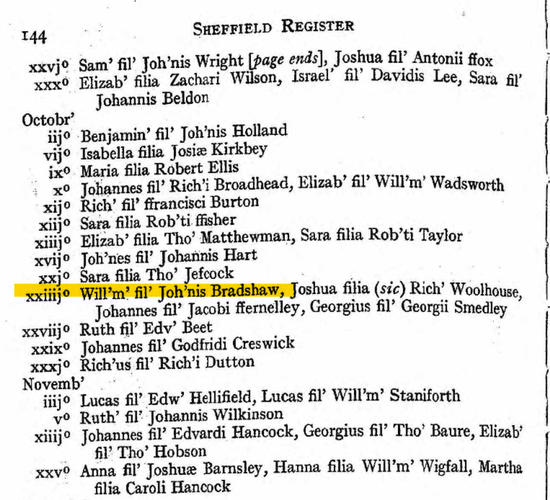
(I edited this because I'd originally attached the wrong image)
Note all the given names have been Latinized. William's father's name was not Johannes, it was John.
Moving onward...
Unless otherwise noted, all dates listed are pulled from primary sources or transcriptions of primary sources IE, court, church, and civic records.
In 1688 he was apprenticed for 8 years to Anthony Coumb of Crookesmoor side or Shiregreen (Leader doesn't seem sure, but Crookesmoor is far more likely since it's immediately adjacent to Steel Bank) and freed in 1698.
Records get murky here, but Ancestry has three or four member-created family trees that say William Bradshaw married Mary Hoole on July 2nd, 1702. None have a primary source citation and I can't find any records of it, but this is likely for many obvious reasons and I'm going to operate on the theory that this is good information (I don't really like to use unsourced information like this, but when that's all there is to go on and it fits into the pattern, what else can ya do?).
They had, as was the custom, a zillion kids:
- John baptized May 9th, 1702. Apprenticed to his father in 1717. Freed 1724. Married Mary Foster in 1729. Had six kids: Ruth, Anne, Mary, John, Martha, Joseph. Died Mar 1st, 1733
- Joseph bapt. Dec 27th, 1705. Died 1710
- William bapt. Nov4, 1708 -- zero records apart from baptism. Which is very odd since he must be the William Bradshaw apprenticed to John Hoole.
- Christopher bapt. Jan 4th, 1712. Apprenticed to his father and freed in 1732. One year later married Lidia Cooke in a double wedding ceremony with his sister Mary. No further records.
- Matthew bapt. Jan 28th, 1715. Apprenticed to his father and freed in 1737. In 1740 he married Hannah Parker. They had many children, two sons he apprenticed and the third (Robert) was apprenticed to 'Window Bradshaw', who was not his mother because his father was still alive. No death record.
- Mary bapt. May 16th, 1718. Married Jonathan Woolhouse, cutler in 1733 in a double wedding ceremony with her brother Christopher. No further records.
William (I) died and was buried on August 4th, 1728 at the ripe old age of 53.
But there was undoubtedly a William Bradshaw, cutler working for quite some time after that, and he looks to have been a pretty terrible person:
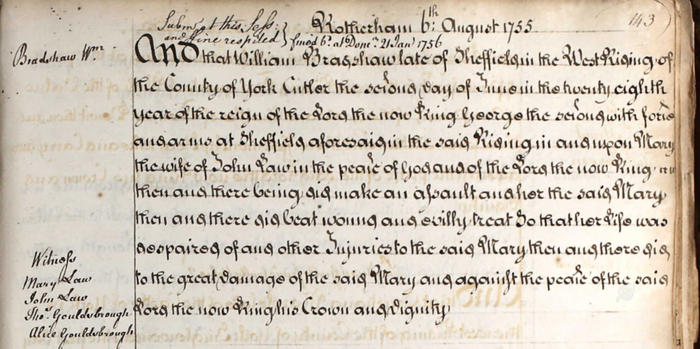
That says, essentially, that in 1755 he nearly beat John Law's wife Mary to death. No reason is given. He was prosecuted, but not done yet!
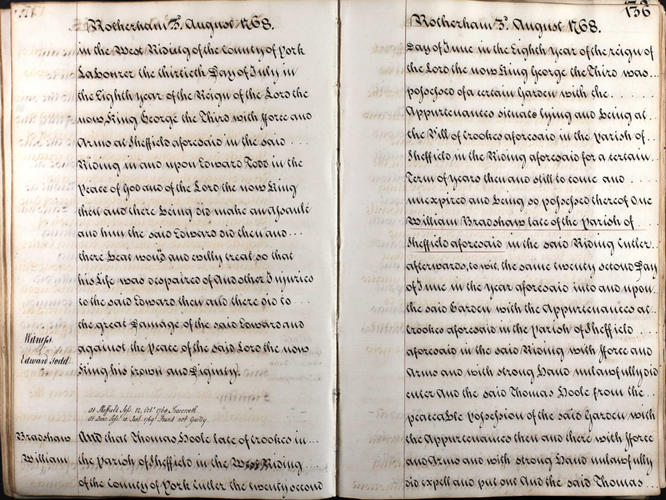
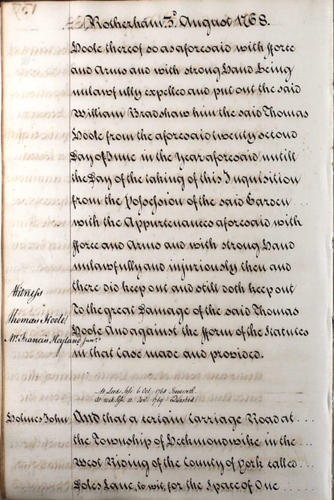
That more or less says that in 1768 he gathered up some guys with some weapons and kicked Thomas Hoole out of his own garden, then prevented him from going back in until the courts intervened.
This almost has to have been the William Bradshaw who was apprenticed to John Hoole. John was his uncle. The Thomas Hoole that got kicked out of the garden was his cousin. Apparently, there wasn't significant bad blood between the families after that incident because by the end of the 18th century, there was a Thomas Bradshaw Hoole born.
It's worth noting here that the Bradshaws, despite being extremely prolific, never occupied any position of note within the Cutler's Company. They probably were not particularly successful.
I am fairly convinced the razor was made by William Linley in the 1770's, but wow has this been a fun (and sometimes frustrating) excursion. I was able to turn up far more genealogical information than I expected for a family that far back and that far down the totem pole.Last edited by Voidmonster; 10-13-2018 at 01:42 AM. Reason: Had the wrong image in there.
-Zak Jarvis. Writer. Artist. Bon vivant.
-
The Following 4 Users Say Thank You to Voidmonster For This Useful Post:
32t (10-13-2018), 782sirbrian (10-16-2018), MikeT (10-13-2018), ScienceGuy (10-13-2018)
-
10-13-2018, 01:11 AM #60


 317Likes
317Likes LinkBack URL
LinkBack URL About LinkBacks
About LinkBacks







 Reply With Quote
Reply With Quote

